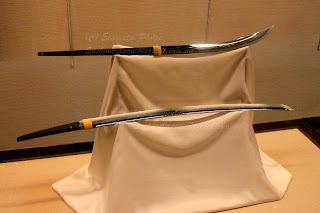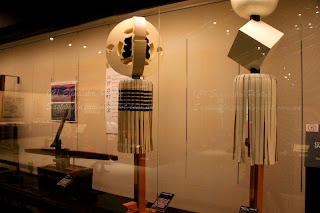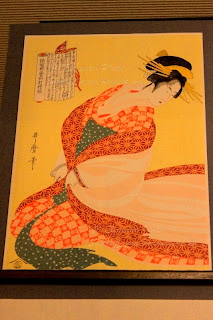The Edo period (1603 - 1868) ended with the Meiji restoration, and Edo was renamed Tokyo. Japan had long been closed off to foreign trades and missions but the actions of Commodore Perry's black ships in 1853 and the various trade treaties with different countries thereafter forced Japan to gradually abandon its isolationist policy and to progressively open its ports to foreign trades. Initially responding with great fear and confusion (culminating in various rebellions and conflicts), the Japanese government and people eventually accepted the new situation, leading to the rapid modernization of Tokyo and Japan.
The Edo-Tokyo Museum is a unique building, both in its design and purpose. It looks exactly the same from the front and the back, stands elevated in the air by 4 large columns, and is accessed via lifts and elevators. Its role is to capture the essential history of the city of Tokyo from its Edo (old name of Tokyo) roots, including detailed reconstructions of various buildings and landmarks, and displaying carefully preserved artifacts from bygone days. One thing that's not captured in the photos below are the employees dressed up in the costumes and hairstyles of old Japan - highly fascinating, and you might even see one dressed in full gear commuting on the train to and from work. All in all, a fun day out for the family or groups.
The Edo-Tokyo Museum though not sure if this is the front or the back. Lol.
Original Nihonbashi ("Japan bridge") made of wood & later reinforced with metal bits. It was destroyed in an earthquake and resulting fire.
Reconstructed example of a mayor's (huge) residence.
This series of panels depicts the entire Edo historical period.
Example of a high street in Edo.
Close up view of the amazingly detailed houses and figurines.
A two-man hand-carried carriage (think 'taxi') for the upper class and those who can afford it.
Love that authentic and well-preserved samurai armour set.
The bronze bust of Tokugawa Ieyasu. Supposed to be dark-brown in colour. Not sure how my camera captured the rainbow colours. Lol.
Naginata sword at the top - long handle, short blade. Tachi sword at the bottom - short handle, full-length blade.
That's an early picnic set. ^^
Early water filtering equipment plus storage well.
Reconstructed example of an Edo-period residence.
Example of a wooden residential house common in Edo.
These are company emblems for different firefighting units in Edo. Since Edo was mainly a wooden city, the threat of fire was real and constant. Those units were localized in specific areas of the city.
A mural depicting a firefighting unit in action. The wooden pail in front was one of the equipment they used to fight fire.
Example of an early wood-worker's house-cum-workplace.
Early toothbushes! XD
Recipe books - good to see the Edoites' dedication to quality food. ^^
Example of an early high-quality Ukiyo-e (or "woodblock print"). It involves imprinting on the same piece of paper using various wood blocks carved with distinct lines and imbued with different colours to form the final complete artwork - a time consuming process requiring very high precision work.
Example of an Edo period bookstore.
Merchants were considered the lowest class in Edo but that did not stop them having large residences-cum-storages-cum-businesses, the above of which is an example.
Examples of various artifacts including a mini water wheel.
Incredible details on an Edo period trading vessel.
A model recreating the busy Edo port.
Reconstruction of the inside of a Kabuki theatre. Kabuki is the classical Japanese dance and drama artform.
Life-sized Kabuki doll "performer" #1.
Life-sized Kabuki doll "performer" #2.
Life-sized Kabuki doll "performer" #3.
An early Kabuki theatre with an outdoors performance area.
Example of an early float used in festivals.
Following the opening of Japanese ports, there were influxes of Western knowledge and technologies. The above is an example of an early Western bicycle found in Tokyo.
A huge underground model of the residence used to accommodate foreign dignitaries and visitors, and its well-kept grounds.
Well-preserved example of a man-powered rickshaw.
An early public telephone.
A famous storage building in Yokohama designed by the British. The original was destroyed in an earthquake.
Good ol' Ford Model A.
Firefighting equipment - or "fire mops" as my friend and I nicknamed them. :P
Example of an early car the size of a mini. There's a hilarious photo to its side depicting a sumo wrestler entering/exiting the car.







































No comments:
Post a Comment